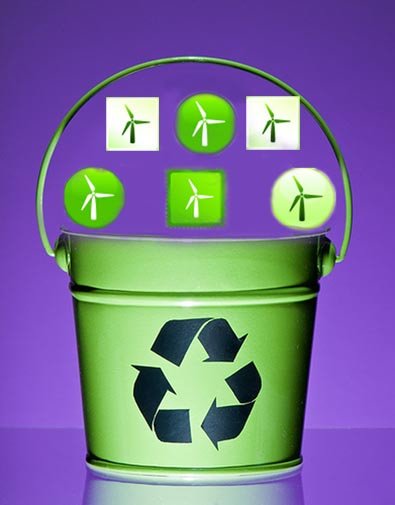
Home | Water wisdom | Plastic Vs. Green |
Energy | Green Entertainment | Wear Green
What's
Power?
"Power
is the rate at which energy is generated or consumed," Gipe
says, "that is, kilowatt-hours per hour or kilowatts .One kilowatt is
1,000 watts . One megawatt is 1,000 kilowatts or 1
million watts.The distinction
between kilowatts and kilowatt-hours is critically important. Knowing the
difference can keep you from being confused by a wind turbine�s size in kilowatts
(or for very small wind turbines, watts), and how much energy, in
kilowatt-hours, it will actually produce. Some unscrupulous manufacturers play
upon the public's ignorance of this distinction and give their wind turbines a
very high "power rating" when the actual turbine is unlikely to
deliver as much electricity as a competitor with a low power rating."
What's
Energy?
Energy
is the ability to do work or the amount of work actually performed. For our
purposes here, energy is given in kilowatt-hours (kWh) of electricity produced
by a wind turbine or consumed in a home or business. When most people pay their
utility bill, they pay for the electricity they consumed in kWh.
Benefits
of using wind power?
Wind
is a clean fuel and offsets pollution from other sources, such as electric
power generated by your utility company. A typical 10 killowatt
wind turbine will offset approximately 1.2 tons of air pollutants,
and 250 tons of greenhouses gases over its operating period.
How
does windpower compare with other renewable energy
sources?
Small
wind turbines may be the least expensive power option for a home not connected
to the utility. Wind power is economically competitive in rural settings with
other energy sources like photovoltaics (solar power)
and biomass. Are wind turbines safe for people, structures, and animals? Wind
turbines have an excellent safety record. A chance of a tree falling on a house
is greater than any danger from a wind turbine. Some people are concerned with
ice accumulating on the blades. If this happens, the ice will usually fall
straight down instead of being thrown. Birds rarely collide with small
residential wind turbines.
How
Does This Save You Money?
Saving money means lowering the cost of installation and operating costs, or
increasing your turbine's productivity. You'll make more money if the tariff
for wind energy increases, too (it just did: in
Basically,
the "power" rating of a wind turbine�what manufacturers use to false
market their goods�is actually an unreliable way to gauge how much energy a
wind turbine will capture. Gipe says you should
concentrate on the actual energy itself, and in particular the rotor
diameter�which is the most reliable indicator of how much electricity a wind
turbine will generate.
So
when you're shopping for your turbine, remember to ask about energy and inquire
about the rotor diameter. The rotor the most important aspect of a wind
turbine�is the part right behind the blades, which facilitates the blades
sweeping the air, and thereby generating energy. Bigger diameter, in this case,
catches more energy from the wind. The question is,
what size you need. Household-size wind turbines generate about 10kW, with
rotors about 100 feet in diameter, for example, whereas large wind turbines can
generate 3MW, with rotors 500 feet in diameter.